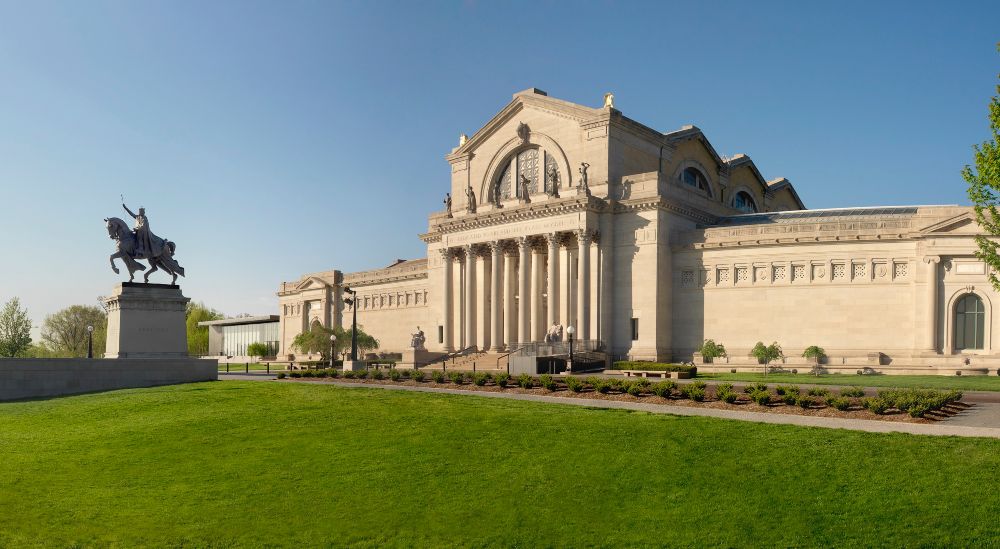I recently spent a Sunday in St. Louis, a rising multicultural city with a legacy of wealthy benefactors from its glory days in the late 19th century. In the morning, we strolled in the magnificent, many-rotunda-ed Tower Grove Park in the Shaw neighborhood, so named as a tribute to Henry Shaw, a wealthy industrialist who gave the land for the 150-year-old park.
Then on to a nearby coffee shop, vibrant with young people. Then to the St. Louis Art Museum, a relic of the 1904 World’s Fair. The museum, fitting the ethnic composition of the city, is rich in German art, has a striking modernist addition, and (best of all) has been admission-free from the year (1904) it was founded. It is kept free by a generous countywide arts tax, donations, and endowment. The museum is set in the glorious Forest Park, where the Meet-Me-in-St.-Louis fair was held. Again, all free, including the Zoo.
It occurred to me that making some of Seattle arts free, thus improving access for young people and those of limited income, would be a worthy imported idea to both help the arts (struggling post-pandemic) and to broaden audiences. And to help with the downtown revival. Instead, we tend to price such attractions to milk tourists and boost memberships.
It turns out that Germany, France, Italy, and Spain now have programs for free tickets aimed at young people. A typical stipend is 200-500 Euros aimed at 18-year-olds, who have two years to spend the grants on tickets, books, art courses, and musical instruments. The grant program is focused on smaller arts groups and prevents teenagers from blowing the entire grant on rock concert tickets.
These programs are described as “cultural start-up capital.” They are easy to administer, since the recipients choose how to spend the money. The cost to Germany will be 100 million Euros per year, and that will reach 750,000 18-year-olds in 2023. That may seem like a lot, but consider that the entire German cultural budget is 2.3 billion Euros a year. I would imagine that in Seattle a goodly portion of the expense would come from foundations bent on improving cultural access and diversity.
My deeply satisfying day in St. Louis concluded with a rousing concert in Powell Hall by the St. Louis Youth Symphony. Ticket cost: $10 each. No charge for the good idea for funding the arts! Meet me in St. Louis, Louie!

What a well-written post! Funny enough I enjoyed the St. Louis Art Museum yesterday. Their collection has all the top names. In fact, the collection is so abundant that one of my favorite pieces is now in storage (“Keith” by Chuck Close). Lol.
-Peter Schrappen (Wallingford resident)
Don’t miss Kehinde Wiley‘s offering!
Wonderful article, David, much thanks. The cynic in me suspects this wouldn’t ever fly in Seattle; the hopeful side of me says, “Why not try.” I spent yesterday on Capitol Hill. Elliott Bay Bookstore, The Comet, all of the wonderful old landmarks were jammed with young people, and some new places I’d never been in.”Come on in!” hollered a server, who must have 30 years younger than me. I know you wrote this with downtown Seattle in mind. But if people are still not ready to revitalize downtown, then on Broadway, 10th Avenue, etc, Volunteer Park, etc. If a foundation doesn’t currently exist for funding, I hope one will soon…I know I’d support it.
Ms. Saunders: I wonder if in fact downtown Seattle has shifted its center of gravity to South Lake Union or, as you suggest, Capitol Hill. If so, a case could be made for creating arts zones there, rather than all the obstacles for downtown. Also, it might make sense to try the idea of dramatically reduced and free programs in one of these new downtowns and later, if it succeeds, migrate to the CBD.
Yes! It’s certainly seems possible to try a program of reduced or free programs in an area that already has a propensity for art and music and inclusivity, before launching them in a “new downtown”. One reason Cap Hill holds a special place for me, besides the obvious friendliness of the crowds, is the large number of modest dives, fragrant with Seattle history, that refuse to go away. Linda’s Tavern, for example, reportedly the last place anyone saw Kurt Cobain alive, scribbling in a corner…flourishing! The Comet, with its famous “all welcome” front door not just standing, but packed with young people. Seattle Central College’s grassy South courtyard. Cap Hill has had its share of growth and crime, but still holds up its rainbow-hued head. It might indeed be a revival that extends to the CBD. If Saint Louis can do it, why not Seattle?
Agree with the Brewster Free Admission Initiative.
Exhibit A when it comes to free admission for the arts are the various elements of The Smithsonian – museums, galleries, the National Zoo — in Washington. Open 364 days a year, closed on Christmas. Timed passes required for a couple of the most popular sites — African-American and Air and Space Museums — but still no charge.
We taxpayers support the institution so only fair that we can wander in at will. Grateful for that.